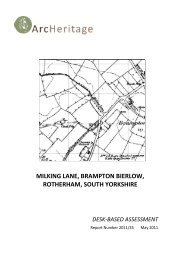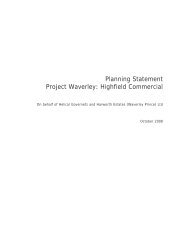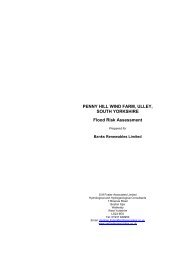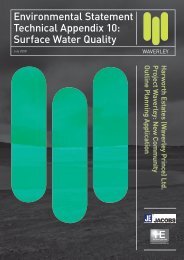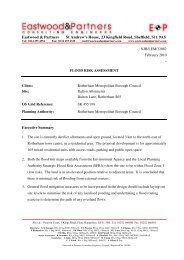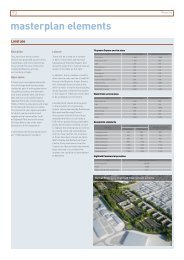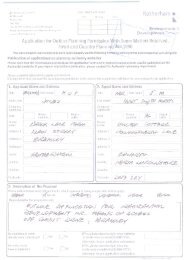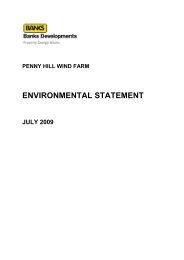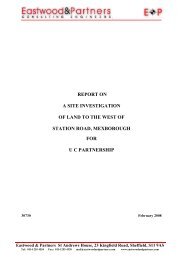environmental statement - Rotherham's Online Application for ...
environmental statement - Rotherham's Online Application for ...
environmental statement - Rotherham's Online Application for ...
You also want an ePaper? Increase the reach of your titles
YUMPU automatically turns print PDFs into web optimized ePapers that Google loves.
Table 6.3: Photomontages<br />
A photomontage is the superimposition of a rendered, photorealistic, computer generated<br />
model of a structure (in this case wind turbines and associated structures) on to a baseline<br />
photograph.<br />
Baseline photographs were taken using a Canon EOS 30D digital SLR camera using a high<br />
quality lens accurately calibrated to provide the equivalent of a 50mm lens on a traditional SLR<br />
camera. All pictures were taken using a levelled tripod and using a high quality setting of 8.2<br />
megapixel resolution. Each of the viewpoints presented in the ES is made up of several<br />
photographs which have been stitched together using Adobe Photoshop software. During the<br />
stitching process none of the photographs were distorted in terms of scaling.<br />
At the time the baseline photographs were taken, co-ordinates of the viewpoints were recorded<br />
using a GPS. Photographs were taken at 1.7m above ground level (i.e. approximately eye<br />
level).<br />
A 3D wireline model was generated of the development features, including turbines,<br />
meteorological mast, access tracks and the sub-station. LSS v9.60 by McCarthy Taylor<br />
Systems Ltd was used to generate the 3D model of the turbines and associated structures.<br />
The model of the structures was rendered and lighting was set appropriate to the date, time<br />
and orientation on which the photograph was taken.<br />
A digital ground terrain model was generated in LSS v9.60 by McCarthy Taylor Systems Ltd<br />
where the development was overlaid on top of it. Using world coordinates in the computer<br />
modelling programme the photographic viewpoints were replicated such that a view was set up<br />
looking at the structures from exactly the same location as where the baseline photograph was<br />
taken from. The view from the model was then superimposed over the original photograph and<br />
edited as necessary in Adobe Photoshop to give a final photomontage. Several known<br />
landmarks in the far distance of the baseline photographs were recorded on site using a GPS<br />
and used to check that the positioning and scale of the structures was correct.<br />
Whilst every ef<strong>for</strong>t has been made to ensure the accuracy of the photomontages, it must be<br />
appreciated that no photomontage could ever claim to be 100% accurate as there are a<br />
number of technical limitations in the model relating to the accuracy of in<strong>for</strong>mation available<br />
from Ordnance Survey and from the GPS. For a detailed discussion regarding the limitations of<br />
photomontages, please refer to Visual Representation of Windfarms – Good Practice Guidance<br />
(SNH commissioned report FO3 AA 308/2).<br />
In particular, it should be recognised that baseline photographs on which photomontages are<br />
based can, at best, only ever be a „flattened‟ 2D representation of what the eye sees in 3D on<br />
site. A photograph will never capture as much detail as the eye would see in the field, it<br />
there<strong>for</strong>e follows that a photomontage can never truly capture the sense of perspective and<br />
detail which would be possible in reality. Taking account of the inherent technical limitations in<br />
producing and presenting photomontages, the photomontages <strong>for</strong> Penny Hill have been<br />
produced according to best practice.<br />
There<strong>for</strong>e the wirelines are simply a tool to assist the Landscape Architect in his/her<br />
assessment of effects. The assessment of visual effects in this section does not rely solely on<br />
the accuracy of the photomontages. Professional judgement has been used to evaluate the<br />
significance of effects.<br />
An interpretation of monocular perspective could be obtained by viewing the photomontages<br />
from a distance of 250mm curved through an appropriate radius.<br />
58<br />
Penny Hill Wind Farm<br />
Environmental Statement



